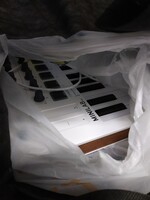
"Chariot Habitat and Exploration Space Station" (code name "project CHESS") is one of the very few vessels of Alliance, built entirely in space due to the need for perfect alignment and sheer size of it - with dome maxing out at almost a kilometer in diameter. Since the the race to build bigger and bigger ships started to grinded to a halt by the time Chariot was complete, each new contender was only slightly wider or loftier than the one before. This station, which construction started way back in the age of the New Sun, was the largest of it's time, putting itself in 7th place among the largest built to this day. Of course, we take into account only those we know were in commission so "Cassandra II" and "Pandora" are not on this list.
Chariot monuments the desire of Alliance to show their power, their intention to travel space how -they- saw fit. But architects were running out of ways to top their previous efforts. One of the main objectives was deep space travel - long distances without the need for fuel or food. And yet we know that in the last transmission that came through right before the ship entered the silent region of space there was enough food and water onboard for five years with gardens and feral chicken farms providing fresh produce and enough energy to turn air into water and vise versa. So what innovations allowed for such a leap in space exploration?
By the beginning of the New Sun, cryonics proved itself a failure and sleeping pods had yet a long way to come to become the ones in use today and at the time of Chariot were unable to contain a living being in a state of hibernation for longer than 3 months. This and some other issues forced brilliant architects and engineers to think of ways to make life flourish onboard. We don't know all of the details, but from what I gathered inside the dome itself there was enough infrastructure for a colony to live for years, even in the event of the greenhouses, purification plants, and a tritium reactor of the main station going offline.
And as you probably guessed the ship is indeed called Chariot because of how it looks. The oldest known chariots have been found in burials of the Sintashta culture on the now-extinct planet in sector E-621 and date back to 200,000 BS. The chariot was a fast, light, open, two-wheeled conveyance drawn by two or more feral horses that were hitched side by side, and was little more than a floor with a waist-high guard at the front and sides. It was initially used for ancient warfare during this planet's Bronze and Iron Ages, but after this, its military capabilities had been superseded and chariots continued to be used for travel, in processions, for games, and in races, making clouds of dust as they passed by. But the wheel of this station was never intended to touch ground and if it did - the consequences would be catastrophic.
For most of the space travel history use of heavy building materials made it difficult for ships to launch and maintain orbit. This three-kilometer wide and half-kilometer thick tungsten wheel weighs around 90,667,500 tons and would've required 1,500,000 trips of SHLLVs. The invention of space lift made building on-orbit much cheaper and faster.
In operation, the main wheel spins between 60 and 15000 rpm. Its purpose is to store energy from when the reactor runs hot and feed this motive power back into the system when needed. This mechanism is widely known as a flywheel. Since the disk is suspended in a vacuum and held by strong permanent magnets this system experiences very little natural loss of power.
But what if the main reactor runs out of fuel? The solution may surprise you. You see the ridges on the flywheel are not for decoration. To power the station without the internal energy source Chariot is forced to "pay a visit" to the nearest planet and "lend" its energy. By lowering itself to close orbit Chariot can perform a slingshot maneuver and at the same time use the atmosphere of the said planet to push on the ridges and spin the wheel up, just like water would in a mill.
Construction began, promising to complete this revolutionary design that would dwarf the competition in just 150 years. Yet it took a bit longer and 167 years after space lifts got to building site orbit with the first cargo, the vessel was complete, surpassing the previous record-holder in energy savings by over 60%, implementing never used before massive ion engines and reflectoid solar panels.
Here is where the story gets... unclear. As we don't know for sure whether this ship is headed to 23-67 or nearby galaxies for exploration of the region or it's course lays far beyond...
Stay curious everyone!
Wow, that was nice to write such a techy story, hope it was an interesting read uvu
Happy holidays :3
Chariot monuments the desire of Alliance to show their power, their intention to travel space how -they- saw fit. But architects were running out of ways to top their previous efforts. One of the main objectives was deep space travel - long distances without the need for fuel or food. And yet we know that in the last transmission that came through right before the ship entered the silent region of space there was enough food and water onboard for five years with gardens and feral chicken farms providing fresh produce and enough energy to turn air into water and vise versa. So what innovations allowed for such a leap in space exploration?
By the beginning of the New Sun, cryonics proved itself a failure and sleeping pods had yet a long way to come to become the ones in use today and at the time of Chariot were unable to contain a living being in a state of hibernation for longer than 3 months. This and some other issues forced brilliant architects and engineers to think of ways to make life flourish onboard. We don't know all of the details, but from what I gathered inside the dome itself there was enough infrastructure for a colony to live for years, even in the event of the greenhouses, purification plants, and a tritium reactor of the main station going offline.
And as you probably guessed the ship is indeed called Chariot because of how it looks. The oldest known chariots have been found in burials of the Sintashta culture on the now-extinct planet in sector E-621 and date back to 200,000 BS. The chariot was a fast, light, open, two-wheeled conveyance drawn by two or more feral horses that were hitched side by side, and was little more than a floor with a waist-high guard at the front and sides. It was initially used for ancient warfare during this planet's Bronze and Iron Ages, but after this, its military capabilities had been superseded and chariots continued to be used for travel, in processions, for games, and in races, making clouds of dust as they passed by. But the wheel of this station was never intended to touch ground and if it did - the consequences would be catastrophic.
For most of the space travel history use of heavy building materials made it difficult for ships to launch and maintain orbit. This three-kilometer wide and half-kilometer thick tungsten wheel weighs around 90,667,500 tons and would've required 1,500,000 trips of SHLLVs. The invention of space lift made building on-orbit much cheaper and faster.
In operation, the main wheel spins between 60 and 15000 rpm. Its purpose is to store energy from when the reactor runs hot and feed this motive power back into the system when needed. This mechanism is widely known as a flywheel. Since the disk is suspended in a vacuum and held by strong permanent magnets this system experiences very little natural loss of power.
But what if the main reactor runs out of fuel? The solution may surprise you. You see the ridges on the flywheel are not for decoration. To power the station without the internal energy source Chariot is forced to "pay a visit" to the nearest planet and "lend" its energy. By lowering itself to close orbit Chariot can perform a slingshot maneuver and at the same time use the atmosphere of the said planet to push on the ridges and spin the wheel up, just like water would in a mill.
Construction began, promising to complete this revolutionary design that would dwarf the competition in just 150 years. Yet it took a bit longer and 167 years after space lifts got to building site orbit with the first cargo, the vessel was complete, surpassing the previous record-holder in energy savings by over 60%, implementing never used before massive ion engines and reflectoid solar panels.
Here is where the story gets... unclear. As we don't know for sure whether this ship is headed to 23-67 or nearby galaxies for exploration of the region or it's course lays far beyond...
Stay curious everyone!
Wow, that was nice to write such a techy story, hope it was an interesting read uvu
Happy holidays :3
Category Artwork (Digital) / Fantasy
Species Unspecified / Any
Size 1280 x 1280px
File Size 1.08 MB

 FA+
FA+








Comments